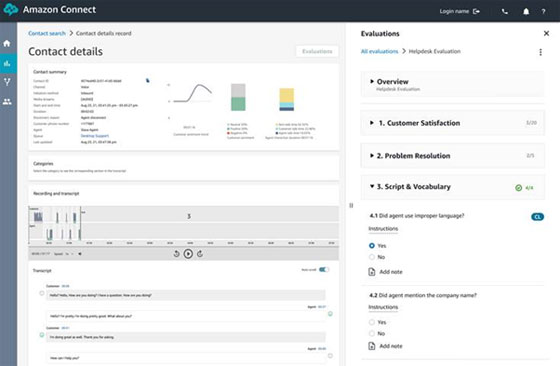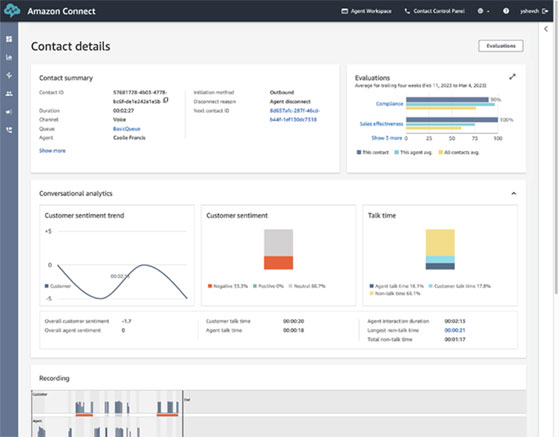AWS has announced the general availability of an automated quality assurance (QA) solution native to Contact Lens.
Contact Lens is the conversational analytics platform that sits inside Amazon Connect.
This latest addition scours every customer conversation, auto-filling an evaluation form.
As such, every contact center interaction receives a score that reflects the agent’s performance.
With that said, service leaders cannot just copy and paste across the quality scorecard that analysts fill out during manual QA sessions. There are limitations.
Nevertheless, Contact Lens will automatically populate black-and-white criteria, such as script adherence, sensitive data collection, and customer greetings.
Here’s a screenshot of the application, which highlights some of the insights Contact Lens generates across every interaction.

With this, service leaders gain a more holistic view of agent performance, which they can harness to spot coaching opportunities and give positive recognition.
In addition, analysts may utilize these new insights to evaluate the interactions that are more likely to shine a light on an agent’s strengths and weaknesses.
Instead of using traditional “lucky dip” evaluation, which agents often find unfair, this allows analysts to look closer under the hood of agent performance to drive positive change.
Moreover, as somewhat evident in the screenshot below, AWS has created a portal to store the automated evaluation. There, analysts may also access a contact summary, word cloud, and a set of performance metrics.

Such metrics include talk and hold time, alongside agent and customer sentiment.
With these KPIs, analysts can perform outlier analysis. In doing so, they may track trends in what drives long handle times and low sentiment.
By addressing the root causes, leaders can enhance service experiences across the board.
From within the portal, analysts may also glean insight into how customer sentiment changes throughout every customer conversation.
Understanding what causes these peaks and troughs will equip service leaders with even more insight into what drives excellent agent performance.
As a result, leaders can continually evolve evaluation criteria to ensure agents understand what they can do to push customer satisfaction forwards.
Yet, these are just some of the possible applications. AWS promises more. In a blog post, members of its team note:
Contact Lens allows organizations to stream evaluation form output data and Contact Records to their data lake – enabling advanced analytics.
The analytics platform processes data from the evaluation form, correlates it, and visualizes the results, enabling the insights above and more.
For instance, a brand could use Contact Lens to gauge customer intent. This would allow analysts to detect patterns in what drives excellent performance across various contact reasons.
Yet, for such strategies to simmer, contact centers must pull together quality analysts and coaching teams who can use these insights to drive performance change with targeted training.
After, automated QA can track the impact of their coaching.
This is another compelling use case for Contact Lens – a product AWS put under the microscope during its Contact Center Day earlier this week.
At the event, AWS celebrated its ranking as a CCaaS leader in the latest Forrester Wave. The vendor also achieved customers’ choice status in the recent Gartner Peer Insights report.
Bolstering its native WFO tooling will help AWS cement these positions – as will its new Step-by-Step Guides and cross-channel concurrency solution.
Yet, expect more to come as AWS continues to bang the contact center drum.







